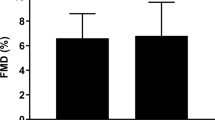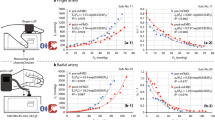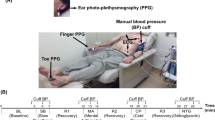Abstract
Flow-mediated dilatation (FMD) is widely used as an index of nitric oxide-mediated vasodilator function, yet its methodology has not been well established. Previous research indicates that a rapid inflation of a blood pressure cuff evokes systemic vasoconstriction, as it was observed even on non-occluded contralateral arm. This would potentially contribute to the variability of FMD readings and complicate the emerging evidence that non-occluded contralateral arm fingertip temperature responses during the FMD procedure may be an indicator of the presence of coronary artery disease. To test the hypotheses that rapid inflation of a blood pressure cuff could reduce FMD values and influence contralateral vasodilatory states, 33 apparently healthy adults (18 males and 15 females, 29±6 years) were studied in two randomized FMD trials. The blood flow-occluding cuff was inflated rapidly (<1 s) in one trial or slowly over 10 s in the other trial. Arterial diameter, fingertip temperature and infrared thermography were obtained throughout each session. FMD values were not different between the rapid and slow cuff inflation trials (5.9±0.6 vs 5.9±0.4%). There were no differences in reactive hyperaemia (6.4±1.6 vs 6.2±1.7 AU), shear stress (80±20 vs 77±17 dyn cm−2) and fingertip temperature rebound (TR; 1.8±1.2 vs 1.9±1.0 °C) between the rapid and slow inflation. Changes in finger temperature on the contralateral (non-occluded) arm were positively associated with those on the occluded arm (r=0.26 to 0.61, P<0.05). We concluded that rates of inflating a blood pressure cuff do not affect FMD and TR response, and that neurovascular-induced vasodilatation of the contralateral arm was not observed regardless of cuff inflation rates.
This is a preview of subscription content, access via your institution
Access options
Subscribe to this journal
Receive 12 digital issues and online access to articles
$119.00 per year
only $9.92 per issue
Buy this article
- Purchase on Springer Link
- Instant access to full article PDF
Prices may be subject to local taxes which are calculated during checkout



Similar content being viewed by others
References
Rossi R, Nuzzo A, Origliani G, Modena MG . Metabolic syndrome affects cardiovascular risk profile and response to treatment in hypertensive postmenopausal women. Hypertension 2008; 52 (5): 865–872.
Deanfield JE, Halcox JP, Rabelink TJ . Endothelial function and dysfunction: testing and clinical relevance. Circulation 2007; 115 (10): 1285–1295.
Dhindsa M, Sommerlad SM, DeVan AE, Barnes JN, Sugawara J, Ley O et al. Interrelationships among noninvasive measures of postischemic macro- and microvascular reactivity. J Appl Physiol 2008; 105 (2): 427–432.
Kuvin JT, Patel AR, Sliney KA, Pandian NG, Rand WM, Udelson JE et al. Peripheral vascular endothelial function testing as a noninvasive indicator of coronary artery disease. J Am Coll Cardiol 2001; 38 (7): 1843–1849.
Celermajer DS, Sorensen KE, Gooch VM, Spiegelhalter DJ, Miller OI, Sullivan ID et al. Non-invasive detection of endothelial dysfunction in children and adults at risk of atherosclerosis. Lancet 1992; 340 (8828): 1111–1115.
Corretti MC, Anderson TJ, Benjamin EJ, Celermajer D, Charbonneau F, Creager MA et al. Guidelines for the ultrasound assessment of endothelial-dependent flow-mediated vasodilation of the brachial artery: a report of the International Brachial Artery Reactivity Task Force. J Am Coll Cardiol 2002; 39 (2): 257–265.
Harris RA, Nishiyama SK, Wray DW, Richardson RS . Ultrasound assessment of flow-mediated dilation. Hypertension 2010; 55 (5): 1075–1085.
Pyke KE, Tschakovsky ME . The relationship between shear stress and flow-mediated dilatation: implications for the assessment of endothelial function. J Physiol 2005; 568 (Pt 2): 357–369.
Marriott I, Marshall JM, Johns EJ . Cutaneous vascular responses evoked in the hand by the cold pressor test and by mental arithmetic. Clin Sci (Lond) 1990; 79 (1): 43–50.
Roddie IC . The decrease in hand blood flow following inflation of an arterial occlusion cuff on the opposite arm. J Physiol 1951; 112 (1–2): 204–210.
Dyson KS, Shoemaker JK, Hughson RL . Effect of acute sympathetic nervous system activation on flow-mediated dilation of brachial artery. Am J Physiol Heart Circ Physiol 2006; 290 (4): H1446–H1453.
Padilla J, Young CN, Simmons GH, Deo SH, Newcomer SC, Sullivan JP et al. Increased muscle sympathetic nerve activity acutely alters conduit artery shear rate patterns. Am J Physiol Heart Circ Physiol 2010; 298 (4): H1128–H1135.
Hijmering ML, Stroes ES, Olijhoek J, Hutten BA, Blankestijn PJ, Rabelink TJ . Sympathetic activation markedly reduces endothelium-dependent, flow-mediated vasodilation. J Am Coll Cardiol 2002; 39 (4): 683–688.
Thijssen DH, de Groot P, Kooijman M, Smits P, Hopman MT . Sympathetic nervous system contributes to the age-related impairment of flow-mediated dilation of the superficial femoral artery. Am J Physiol Heart Circ Physiol 2006; 291 (6): H3122–H3129.
Santos AC, Alves MJ, Rondon MU, Barretto AC, Middlekauff HR, Negrao CE . Sympathetic activation restrains endothelium-mediated muscle vasodilatation in heart failure patients. Am J Physiol Heart Circ Physiol 2005; 289 (2): H593–H599.
Ahmadi N, Nabavi V, Nuguri V, Hajsadeghi F, Flores F, Akhtar M et al. Low fingertip temperature rebound measured by digital thermal monitoring strongly correlates with the presence and extent of coronary artery disease diagnosed by 64-slice multi-detector computed tomography. Int J Cardiovasc Imaging 2009; 25 (7): 725–738.
Gul KM, Ahmadi N, Wang Z, Jamieson C, Nasir K, Metcalfe R et al. Digital thermal monitoring of vascular function: a novel tool to improve cardiovascular risk assessment. Vasc Med 2009; 14 (2): 143–148.
Koltzenburg M, Wall PD, McMahon SB . Does the right side know what the left is doing? Trends Neurosci 1999; 22 (3): 122–127.
Isii Y, Matsukawa K, Tsuchimochi H, Nakamoto T . Ice-water hand immersion causes a reflex decrease in skin temperature in the contralateral hand. J Physiol Sci 2007; 57 (4): 241–248.
Dupuis J, Arsenault A, Meloche B, Harel F, Staniloae C, Gregoire J . Quantitative hyperemic reactivity in opposed limbs during myocardial perfusion imaging: a new marker of coronary artery disease. J Am Coll Cardiol 2004; 44 (7): 1473–1477.
Marshall JM, Stone A, Johns EJ . Analysis of vascular responses evoked in the cutaneous circulation of one hand by cooling the contralateral hand. J Auton Nerv Syst 1990; 31 (1): 57–66.
Gates PE, Boucher ML, Silver AE, Monahan KD, Seals DR . Impaired flow-mediated dilation with age is not explained by L-arginine bioavailability or endothelial asymmetric dimethylarginine protein expression. J Appl Physiol 2007; 102 (1): 63–71.
Eskurza I, Monahan KD, Robinson JA, Seals DR . Effect of acute and chronic ascorbic acid on flow-mediated dilatation with sedentary and physically active human ageing. J Physiol 2004; 556 (Part 1): 315–324.
Mitchell GF, Parise H, Vita JA, Larson MG, Warner E, Keaney Jr JF et al. Local shear stress and brachial artery flow-mediated dilation: the Framingham Heart Study. Hypertension 2004; 44 (2): 134–139.
Stebbins CL, Brown B, Levin D, Longhurst JC . Reflex effect of skeletal muscle mechanoreceptor stimulation on the cardiovascular system. J Appl Physiol 1988; 65 (4): 1539–1547.
Williamson JW, Mitchell JH, Olesen HL, Raven PB, Secher NH . Reflex increase in blood pressure induced by leg compression in man. J Physiol 1994; 475 (2): 351–357.
Berry KL, Skyrme-Jones RA, Meredith IT . Occlusion cuff position is an important determinant of the time course and magnitude of human brachial artery flow-mediated dilation. Clin Sci (Lond) 2000; 99 (4): 261–267.
Mullen MJ, Kharbanda RK, Cross J, Donald AE, Taylor M, Vallance P et al. Heterogenous nature of flow-mediated dilatation in human conduit arteries in vivo: relevance to endothelial dysfunction in hypercholesterolemia. Circ Res 2001; 88 (2): 145–151.
Author information
Authors and Affiliations
Corresponding author
Ethics declarations
Competing interests
The authors declare no conflict of interest.
Rights and permissions
About this article
Cite this article
Lin, HF., Dhindsa, M., Tarumi, T. et al. Impact of blood pressure cuff inflation rates on flow-mediated dilatation and contralateral arm response. J Hum Hypertens 26, 35–40 (2012). https://doi.org/10.1038/jhh.2010.128
Received:
Revised:
Accepted:
Published:
Issue Date:
DOI: https://doi.org/10.1038/jhh.2010.128



